wheel size DODGE DURANGO SRT 2019 Vehicle Warranty
[x] Cancel search | Manufacturer: DODGE, Model Year: 2019, Model line: DURANGO SRT, Model: DODGE DURANGO SRT 2019Pages: 270, PDF Size: 2.52 MB
Page 178 of 270

checked immediately. Tires which have been run underinflated will show
more wear on the shoulders than in the center of the tread.
TIRE MIXING
MICHELIN® tires are radial tires and for best performance it is recom-
mended that the same size and type of tire be used on all four wheel
positions. Before mixing tires of different types in any configuration on
any vehicle, be sure to check the vehicle manufacturer ’s owner‘s manual
for its recommendations.
It is especially important to check the vehicle manufacturer ’s owner ’s
manual when mixing, matching, or replacing tires on 4-wheel drive
vehicles, as this may require special precautions.
MICHELIN DOES NOT RECOMMEND MIXING PAX® SYSTEM TIRES
WITH NON-PAX TIRES / SELF-SUPPORTING ZERO PRESSURE (ZP)
TIRES WITH NON-ZP TIRES OTHER THAN THE TEMPORARY USE
OF THE SPARE IF THE VEHICLE IS SO EQUIPPED.
WINTER DRIVING
Tires which meet the Rubber Manufactures Association (RMA) definition
of snow tires are marked M/S, or M&S. On such tires, this designation is
molded into the sidewall. Tires without this notation are not recom-
mended or winter driving.While All-Season tires are designed to provide reliable
performance in some winter conditions, the use of four
(4) winter tires is recommended for optimal performance.
Tires designate for use in severe winter conditions are
marked on at leas one sidewall with the letter “M”
TIRE ROTATION AND REPLACEMENT
To obtain maximum tire wear, it may be necessary to rotate your tires.
Refer to your vehicle owner ’s manual for instructions on tire rotation. If
you do not have an owner‘s manual for your vehicle, Michelin recom-
mends rotating your tires every 6,000 to 8,000 miles (10,000 to 12,000 km).
Monthly inspection for tire wear is recommended. Your tires should be
rotated at the first sign of irregular wear, even if it occurs before 6,000
miles (10,000 km). This is true for all vehicles.
MICHELIN
177
Page 179 of 270

When rotating tires with a directional tread pattern, observe the arrows
molded on the sidewall which show the direction the tire should turn.
Care must be taken to maintain the proper turning direction.
Some Tire Pressure Monitoring Systems (TPMS) may not recognize
that a tire has been moved to a different position on your vehicle. Make
certain that your TPMS system is reset, if necessary, so as to correctly
identify the location of each tire on your vehicle. Refer to your vehicle
owner ’s manual or your vehicle dealer.
Determine whether rotated tires require tire inflation adjustment as front
and rear position tire pressure may vary according to the vehicle
manufacturer ’s specification due to the actual load on that wheel
position. Some vehicles may have different sized tires mounted on the
front and rear axles, and these different sized tires have rotation
restrictions. Always check the vehicle owner ’s manual for the proper
rotation recommendations.
Full-size Spare
Full-size spare tires (not temporary spares) of the same size and construc-
tion should be used in a five (5) tire rotation. Always check the inflation
pressure of the full-size spare immediately before incorporating it into
rotation. Follow the vehicle manufacturer ’s recommended pattern for
rotation, or if not available, see a qualified tire technician.
Replacement of Two (2) Tires
It is recommended that all four (4) tires are replaced at the same time.
However, when only two tires are replaced, the new tires should be put
on the rear. The new tires, with deeper tread, may provide better grip and
water evacuation in wet driving conditions.
CUSTOMIZATION OF TIRES, WHEELS, OR SUSPENSION ON
SUVS AND LIGHT TRUCKS
Due to their size, weight and higher center of gravity, vehicles such as
SUVs and light trucks do not have the same handling characteristics as
automobiles. Because of these differing characteristics, failure to operate
your SUV/truck in a proper and safe manner can increase the likelihood
of vehicle rollover. Modifications to your SUV/truck tire size, tire type,
wheels or suspension can change its handling characteristics and further
increase the likelihood of vehicle rollover. Whether your SUV/truck has
the original equipment configuration for tires, wheels and suspension or
whether any of these items have been modified, always drive safely,
MICHELIN178
Page 181 of 270

STORAGE
Tires contain waxes and emollients to protect their outer surfaces from
ozone and weather checking. As the tire rolls and flexes, the waxes and
emollients continually migrate to the surface, replenishing this protection
throughout the normal use of the tire. Consequently, when tires sit
outdoors, unused for long periods of time (a month or more) their
surfaces become dry and more susceptible to ozone and weather check-
ing and the casing becomes susceptible to flat spotting.For this reason,
tires should always be stored in a cool, dry, clean, indoor environment.
If storage is for one month or more, eliminate the weight from the tires
by raising the vehicle or by removing the tires from the vehicle. Failure
to store tires in accordance with these instructions could result in
damage to your tires or premature aging of the tires and sudden tire
failure.
When tires are stored, be sure they are placed away from sources of heat
and ozone such as hot pipes and electric generators. Be sure that surfaces
on which tires are stored are clean and free from grease, gasoline or other
substances which could deteriorate the rubber. (Tires exposed to these
materials during storage or driving could be subject to sudden failure.)
FOLLOW THESE MOUNTING RECOMMENDATIONS
Tire changing can be dangerous and must be done by professionally
trained persons using proper tools and procedures as specified by the
Rubber Manufacturers Association (RMA). PAX® System tires must be
mounted and dismounted only by specially trained, authorized PAX
System retailers, utilizing PAX System authorized equipment.
Your tires should be mounted on wheels of correct size and type and
which are in good, clean condition. Wheels that are bent, chipped, rusted
(steel wheels) or corroded (alloy wheels) may cause tire damage. The
inside of the tire must be free from foreign material. Have your retailer
check the wheels before mounting new tires. Mismatched tires and rims
can explode during mounting. Also, mismatched tires and rims can result
in dangerous tire failure on the road. If a tire is mounted by error on the
wrong-sized rim, do not remount it on the proper rim scrap it. It may
have been damaged internally (which is not externally visible) by having
been dangerously stretched and could fail on the highway.
Old valves may leak. When new tubeless tires are mounted, have new
valves of the correct type installed. Tubeless tires must only be
mounted on wheels designed for tubeless tires i.e., wheels which have
MICHELIN
180
Page 183 of 270
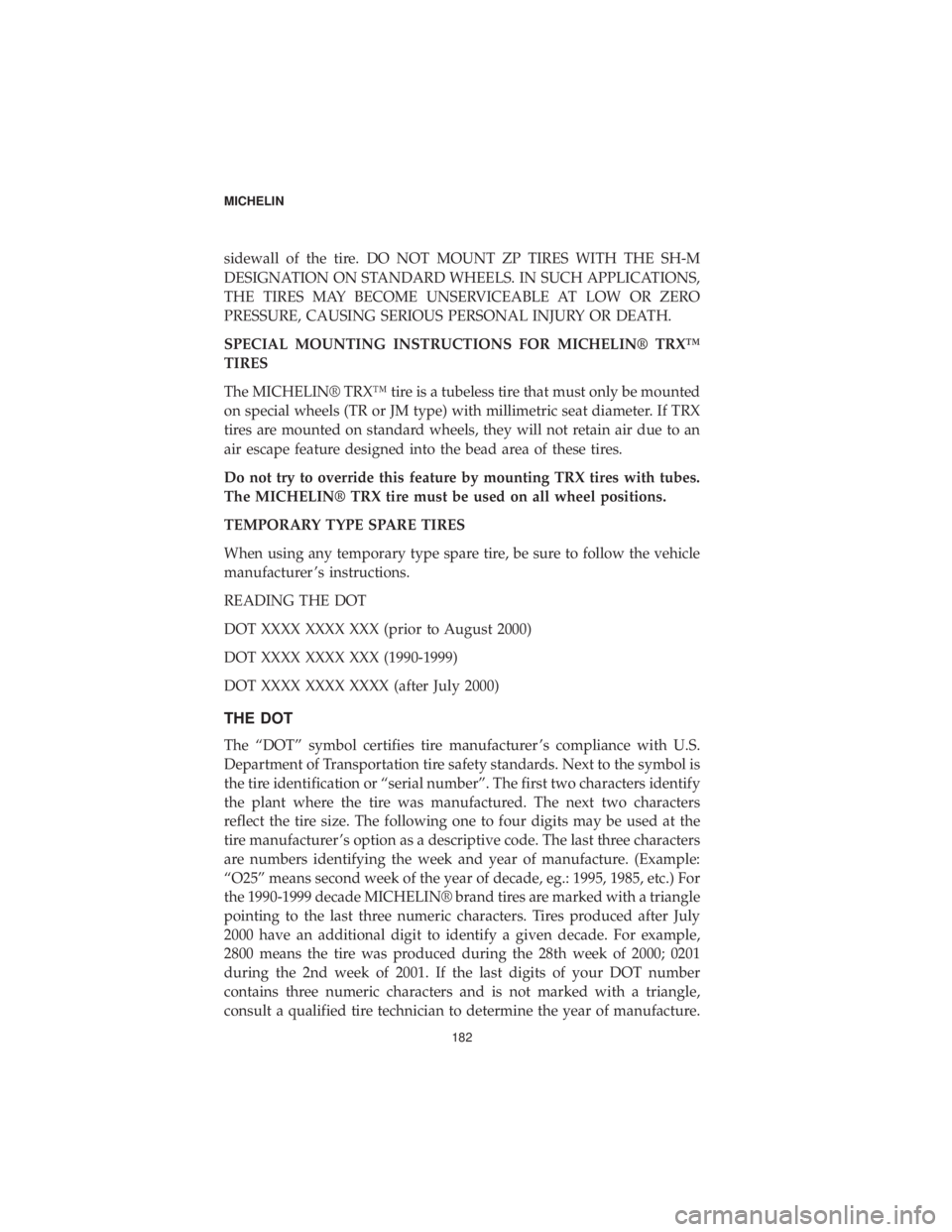
sidewall of the tire. DO NOT MOUNT ZP TIRES WITH THE SH-M
DESIGNATION ON STANDARD WHEELS. IN SUCH APPLICATIONS,
THE TIRES MAY BECOME UNSERVICEABLE AT LOW OR ZERO
PRESSURE, CAUSING SERIOUS PERSONAL INJURY OR DEATH.
SPECIAL MOUNTING INSTRUCTIONS FOR MICHELIN® TRX™
TIRES
The MICHELIN® TRX™ tire is a tubeless tire that must only be mounted
on special wheels (TR or JM type) with millimetric seat diameter. If TRX
tires are mounted on standard wheels, they will not retain air due to an
air escape feature designed into the bead area of these tires.
Do not try to override this feature by mounting TRX tires with tubes.
The MICHELIN® TRX tire must be used on all wheel positions.
TEMPORARY TYPE SPARE TIRES
When using any temporary type spare tire, be sure to follow the vehicle
manufacturer ’s instructions.
READING THE DOT
DOT XXXX XXXX XXX (prior to August 2000)
DOT XXXX XXXX XXX (1990-1999)
DOT XXXX XXXX XXXX (after July 2000)
THE DOT
The “DOT” symbol certifies tire manufacturer ’s compliance with U.S.
Department of Transportation tire safety standards. Next to the symbol is
the tire identification or “serial number”. The first two characters identify
the plant where the tire was manufactured. The next two characters
reflect the tire size. The following one to four digits may be used at the
tire manufacturer ’s option as a descriptive code. The last three characters
are numbers identifying the week and year of manufacture. (Example:
“O25” means second week of the year of decade, eg.: 1995, 1985, etc.) For
the 1990-1999 decade MICHELIN® brand tires are marked with a triangle
pointing to the last three numeric characters. Tires produced after July
2000 have an additional digit to identify a given decade. For example,
2800 means the tire was produced during the 28th week of 2000; 0201
during the 2nd week of 2001. If the last digits of your DOT number
contains three numeric characters and is not marked with a triangle,
consult a qualified tire technician to determine the year of manufacture.
MICHELIN182
Page 203 of 270
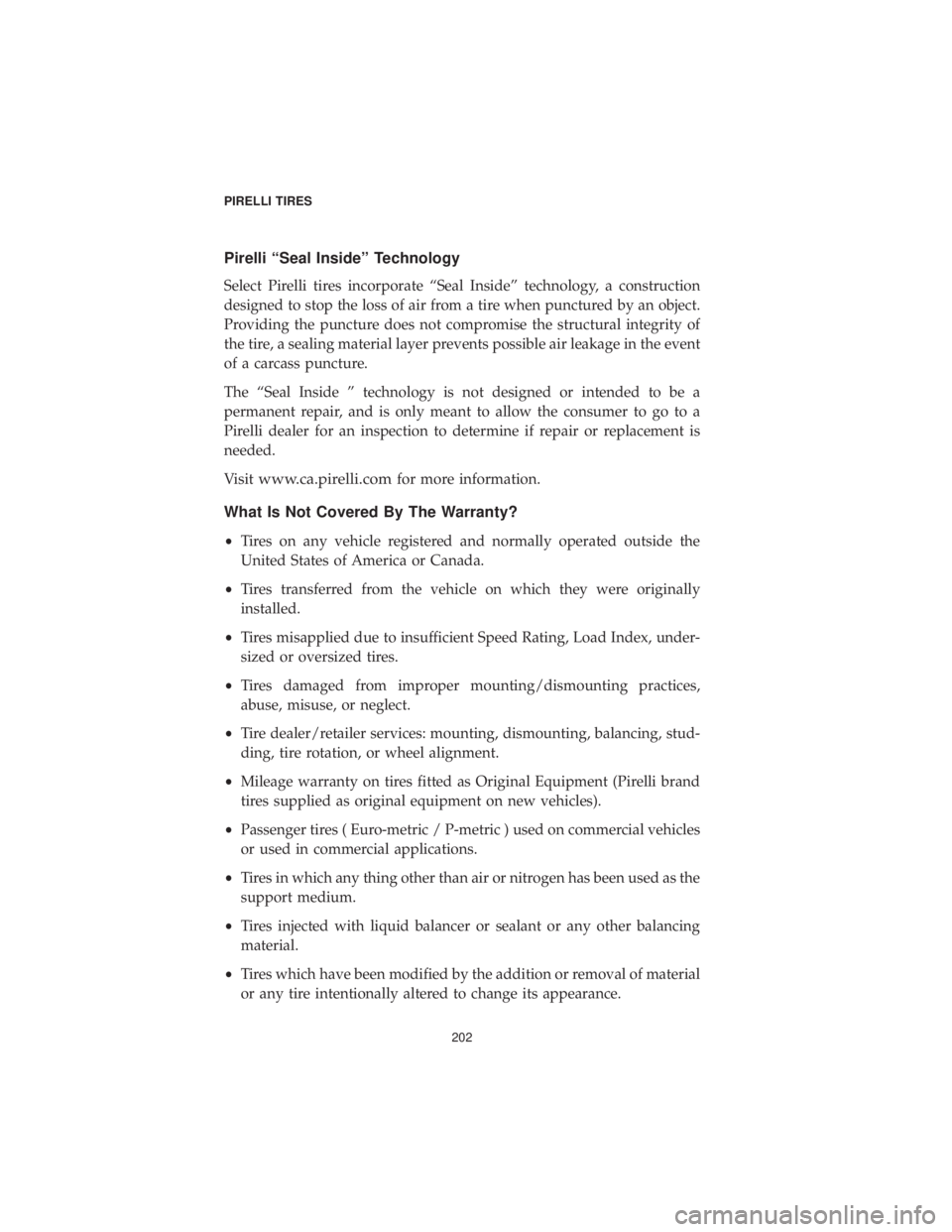
Pirelli “Seal Inside” Technology
Select Pirelli tires incorporate “Seal Inside” technology, a construction
designed to stop the loss of air from a tire when punctured by an object.
Providing the puncture does not compromise the structural integrity of
the tire, a sealing material layer prevents possible air leakage in the event
of a carcass puncture.
The “Seal Inside ” technology is not designed or intended to be a
permanent repair, and is only meant to allow the consumer to go to a
Pirelli dealer for an inspection to determine if repair or replacement is
needed.
Visit
www.ca.pirelli.comfor more information.
What Is Not Covered By The Warranty?
•Tires on any vehicle registered and normally operated outside the
United States of America or Canada.
• Tires transferred from the vehicle on which they were originally
installed.
• Tires misapplied due to insufficient Speed Rating, Load Index, under-
sized or oversized tires.
• Tires damaged from improper mounting/dismounting practices,
abuse, misuse, or neglect.
• Tire dealer/retailer services: mounting, dismounting, balancing, stud-
ding, tire rotation, or wheel alignment.
• Mileage warranty on tires fitted as Original Equipment (Pirelli brand
tires supplied as original equipment on new vehicles).
• Passenger tires ( Euro-metric / P-metric ) used on commercial vehicles
or used in commercial applications.
• Tires in which any thing other than air or nitrogen has been used as the
support medium.
• Tires injected with liquid balancer or sealant or any other balancing
material.
• Tires which have been modified by the addition or removal of material
or any tire intentionally altered to change its appearance.
PIRELLI TIRES
202
Page 204 of 270

•Tires improperly repaired or with repairs not conforming to Tire and
Rubber Association of Canada standards, or with section repairs, or
with a self-vulcanizing plug only or patch only.
• Tires which have been recapped, or retreaded, or regrooved.
• Tires used in racing or other competitive events.
• Tires removed in multiples when only one tire can be claimed, or is
suspect of a claim.
• Ride related anomalies after the first 2/32” of treadwear.
• Tires which become unserviceable because of tire operation in excess of
tire/wheel manufacturers’ specifications and recommendations, in-
cluding spinning.
• Tires which become unserviceable because of a mechanical irregularity
in the vehicle such as misalignment, defective brakes, defective shock
absorbers or struts, or improper rims.
• Tires damaged by fire, chemical corrosion, vandalism, wrecks, chains,
theft, run while flat, under inflated, over inflated or abused during
servicing.
• Tires affected by flat spotting caused by improper transport or storage.
• Tires which became unserviceable because of road hazard injuries (e.g.,
nails, glass, metal objects) or other penetrations or snags, bruises or
impact damage, except for those Run Flat lines/sizes specifically
covered by the Pirelli Road Hazard Policy.
• Tires with weather / ozone cracking which were purchased more than
four years prior to presentation for adjustment. (If no proof of
purchase date is available, the warranty will be four years from the
DOT date).
• Summer tires that developed surface cracks due to use in low ambient
temperatures. These include P Zero Silver, P Zero Trofeo, P Zero Corsa
System, P Zero, P Zero Rosso™, P Zero Nero, Cinturato P1, Cinturato
P7, Scorpion Zero™ and Scorpion Verde.
PIRELLI TIRES
203
Page 211 of 270
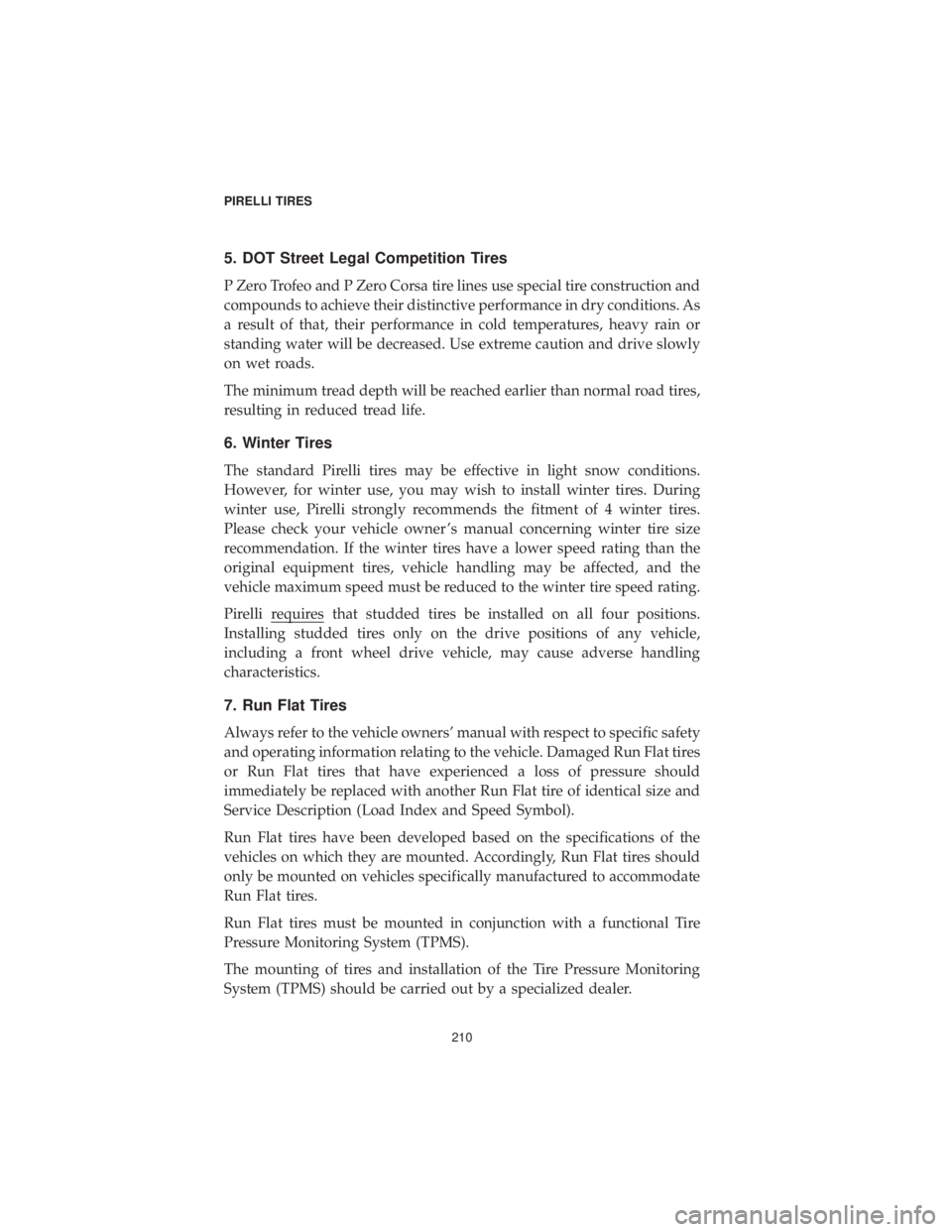
5. DOT Street Legal Competition Tires
P Zero Trofeo and P Zero Corsa tire lines use special tire construction and
compounds to achieve their distinctive performance in dry conditions. As
a result of that, their performance in cold temperatures, heavy rain or
standing water will be decreased. Use extreme caution and drive slowly
on wet roads.
The minimum tread depth will be reached earlier than normal road tires,
resulting in reduced tread life.
6. Winter Tires
The standard Pirelli tires may be effective in light snow conditions.
However, for winter use, you may wish to install winter tires. During
winter use, Pirelli strongly recommends the fitment of 4 winter tires.
Please check your vehicle owner ’s manual concerning winter tire size
recommendation. If the winter tires have a lower speed rating than the
original equipment tires, vehicle handling may be affected, and the
vehicle maximum speed must be reduced to the winter tire speed rating.
Pirelli requires that studded tires be installed on all four positions.
Installing studded tires only on the drive positions of any vehicle,
including a front wheel drive vehicle, may cause adverse handling
characteristics.
7. Run Flat Tires
Always refer to the vehicle owners’ manual with respect to specific safety
and operating information relating to the vehicle. Damaged Run Flat tires
or Run Flat tires that have experienced a loss of pressure should
immediately be replaced with another Run Flat tire of identical size and
Service Description (Load Index and Speed Symbol).
Run Flat tires have been developed based on the specifications of the
vehicles on which they are mounted. Accordingly, Run Flat tires should
only be mounted on vehicles specifically manufactured to accommodate
Run Flat tires.
Run Flat tires must be mounted in conjunction with a functional Tire
Pressure Monitoring System (TPMS).
The mounting of tires and installation of the Tire Pressure Monitoring
System (TPMS) should be carried out by a specialized dealer.
PIRELLI TIRES210
Page 212 of 270
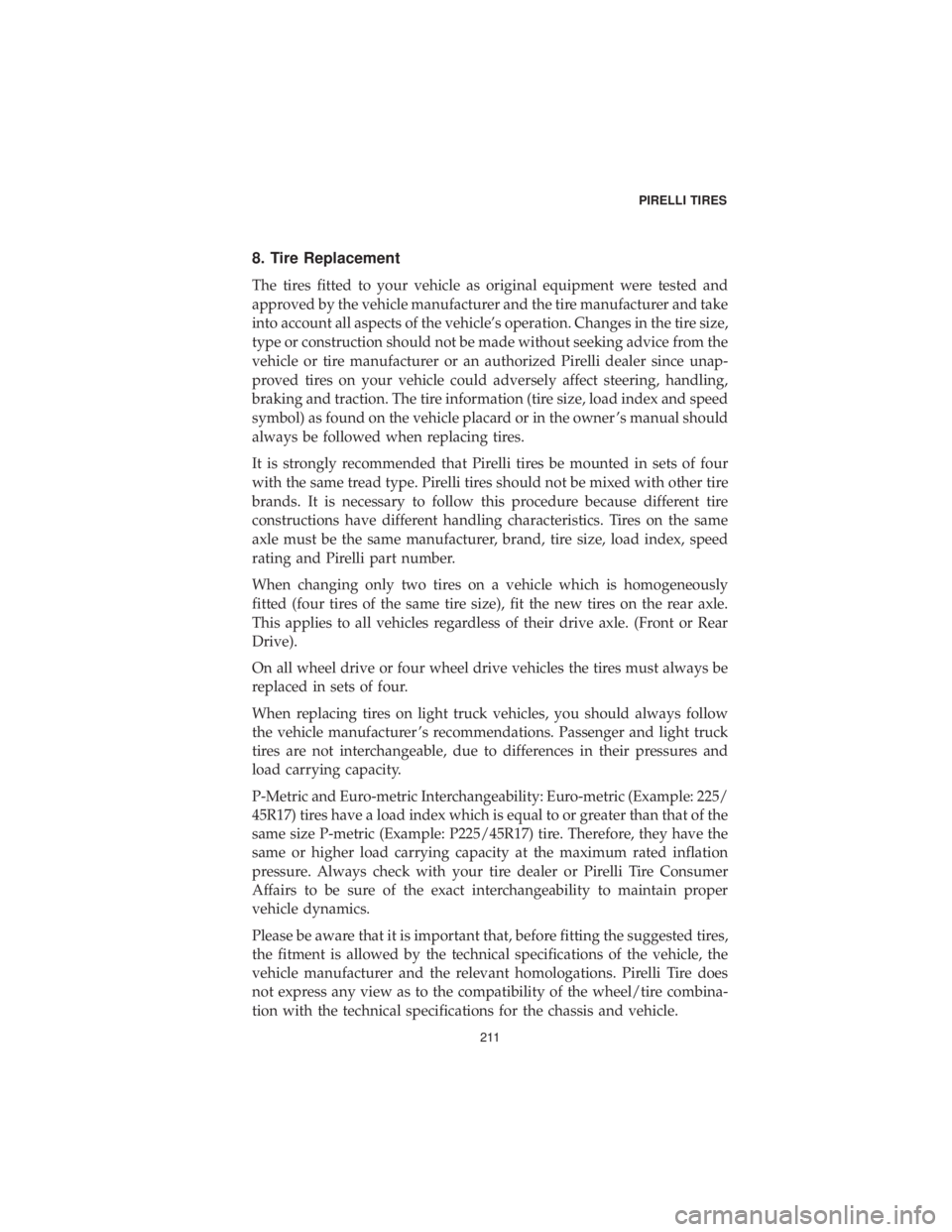
8. Tire Replacement
The tires fitted to your vehicle as original equipment were tested and
approved by the vehicle manufacturer and the tire manufacturer and take
into account all aspects of the vehicle’s operation. Changes in the tire size,
type or construction should not be made without seeking advice from the
vehicle or tire manufacturer or an authorized Pirelli dealer since unap-
proved tires on your vehicle could adversely affect steering, handling,
braking and traction. The tire information (tire size, load index and speed
symbol) as found on the vehicle placard or in the owner ’s manual should
always be followed when replacing tires.
It is strongly recommended that Pirelli tires be mounted in sets of four
with the same tread type. Pirelli tires should not be mixed with other tire
brands. It is necessary to follow this procedure because different tire
constructions have different handling characteristics. Tires on the same
axle must be the same manufacturer, brand, tire size, load index, speed
rating and Pirelli part number.
When changing only two tires on a vehicle which is homogeneously
fitted (four tires of the same tire size), fit the new tires on the rear axle.
This applies to all vehicles regardless of their drive axle. (Front or Rear
Drive).
On all wheel drive or four wheel drive vehicles the tires must always be
replaced in sets of four.
When replacing tires on light truck vehicles, you should always follow
the vehicle manufacturer ’s recommendations. Passenger and light truck
tires are not interchangeable, due to differences in their pressures and
load carrying capacity.
P-Metric and Euro-metric Interchangeability: Euro-metric (Example: 225/
45R17) tires have a load index which is equal to or greater than that of the
same size P-metric (Example: P225/45R17) tire. Therefore, they have the
same or higher load carrying capacity at the maximum rated inflation
pressure. Always check with your tire dealer or Pirelli Tire Consumer
Affairs to be sure of the exact interchangeability to maintain proper
vehicle dynamics.
Please be aware that it is important that, before fitting the suggested tires,
the fitment is allowed by the technical specifications of the vehicle, the
vehicle manufacturer and the relevant homologations. Pirelli Tire does
not express any view as to the compatibility of the wheel/tire combina-
tion with the technical specifications for the chassis and vehicle.
PIRELLI TIRES
211
Page 219 of 270
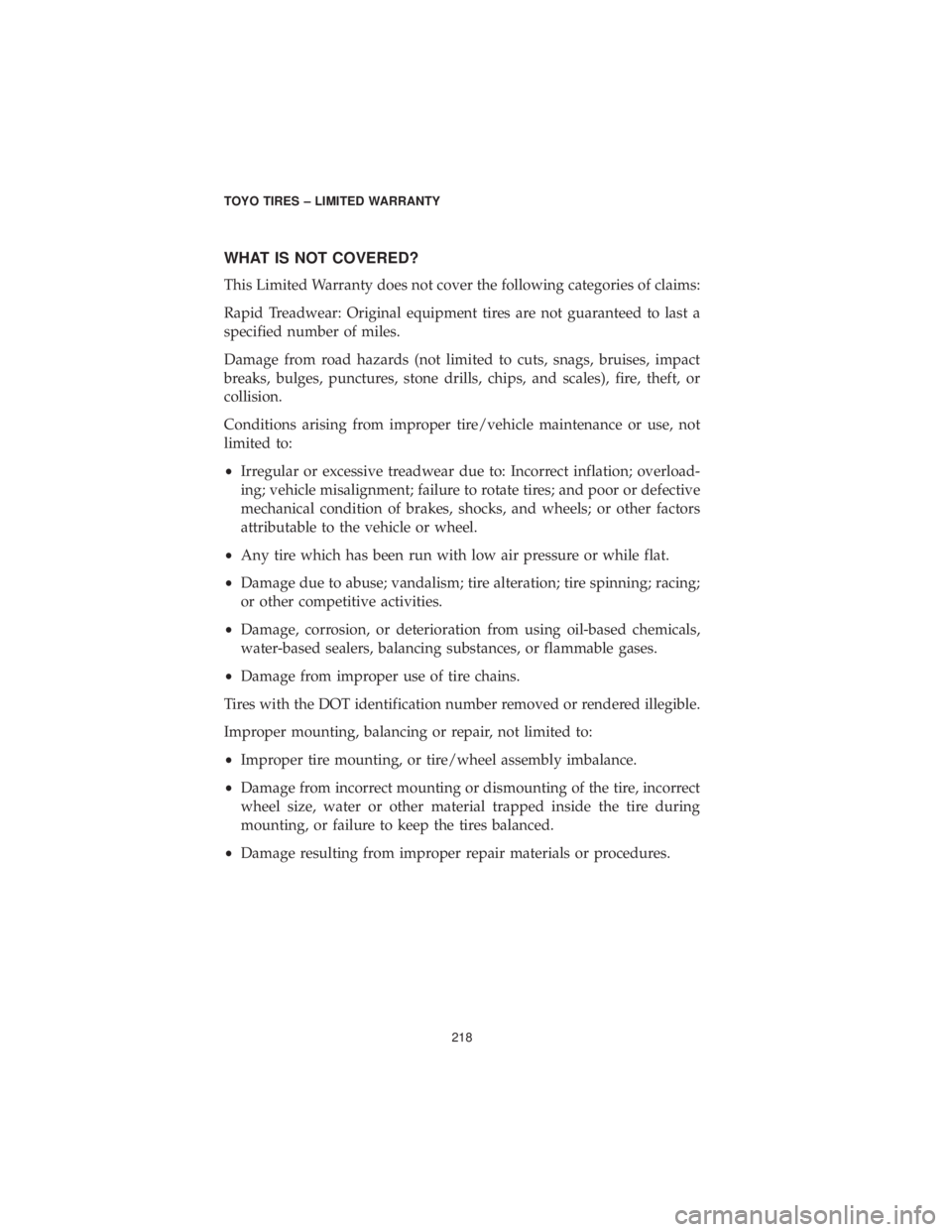
WHAT IS NOT COVERED?
This Limited Warranty does not cover the following categories of claims:
Rapid Treadwear: Original equipment tires are not guaranteed to last a
specified number of miles.
Damage from road hazards (not limited to cuts, snags, bruises, impact
breaks, bulges, punctures, stone drills, chips, and scales), fire, theft, or
collision.
Conditions arising from improper tire/vehicle maintenance or use, not
limited to:
•Irregular or excessive treadwear due to: Incorrect inflation; overload-
ing; vehicle misalignment; failure to rotate tires; and poor or defective
mechanical condition of brakes, shocks, and wheels; or other factors
attributable to the vehicle or wheel.
• Any tire which has been run with low air pressure or while flat.
• Damage due to abuse; vandalism; tire alteration; tire spinning; racing;
or other competitive activities.
• Damage, corrosion, or deterioration from using oil-based chemicals,
water-based sealers, balancing substances, or flammable gases.
• Damage from improper use of tire chains.
Tires with the DOT identification number removed or rendered illegible.
Improper mounting, balancing or repair, not limited to:
• Improper tire mounting, or tire/wheel assembly imbalance.
• Damage from incorrect mounting or dismounting of the tire, incorrect
wheel size, water or other material trapped inside the tire during
mounting, or failure to keep the tires balanced.
• Damage resulting from improper repair materials or procedures.
TOYO TIRES – LIMITED WARRANTY
218
Page 235 of 270
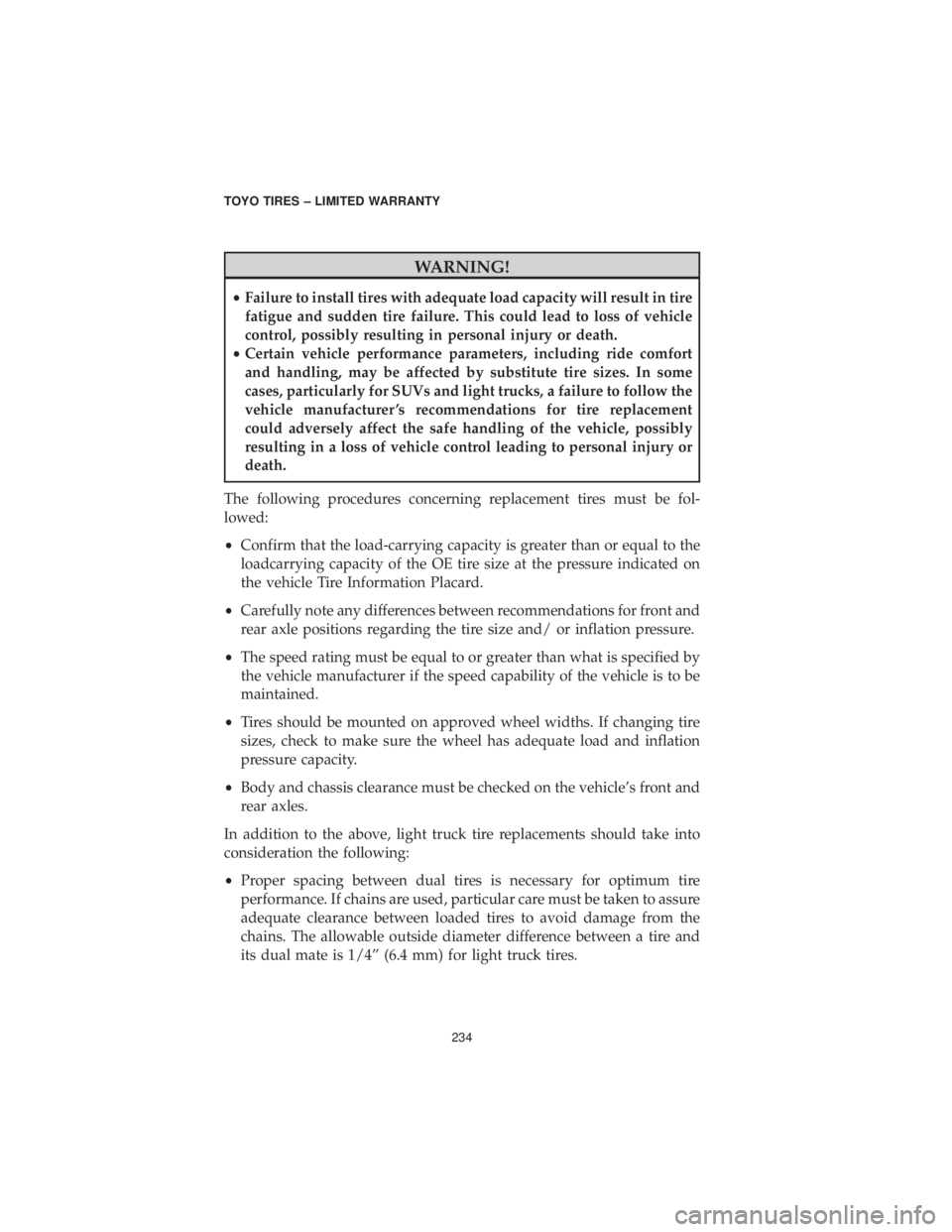
WARNING!
•Failure to install tires with adequate load capacity will result in tire
fatigue and sudden tire failure. This could lead to loss of vehicle
control, possibly resulting in personal injury or death.
• Certain vehicle performance parameters, including ride comfort
and handling, may be affected by substitute tire sizes. In some
cases, particularly for SUVs and light trucks, a failure to follow the
vehicle manufacturer ’s recommendations for tire replacement
could adversely affect the safe handling of the vehicle, possibly
resulting in a loss of vehicle control leading to personal injury or
death.
The following procedures concerning replacement tires must be fol-
lowed:
• Confirm that the load-carrying capacity is greater than or equal to the
loadcarrying capacity of the OE tire size at the pressure indicated on
the vehicle Tire Information Placard.
• Carefully note any differences between recommendations for front and
rear axle positions regarding the tire size and/ or inflation pressure.
• The speed rating must be equal to or greater than what is specified by
the vehicle manufacturer if the speed capability of the vehicle is to be
maintained.
• Tires should be mounted on approved wheel widths. If changing tire
sizes, check to make sure the wheel has adequate load and inflation
pressure capacity.
• Body and chassis clearance must be checked on the vehicle’s front and
rear axles.
In addition to the above, light truck tire replacements should take into
consideration the following:
• Proper spacing between dual tires is necessary for optimum tire
performance. If chains are used, particular care must be taken to assure
adequate clearance between loaded tires to avoid damage from the
chains. The allowable outside diameter difference between a tire and
its dual mate is 1/4” (6.4 mm) for light truck tires.
TOYO TIRES – LIMITED WARRANTY
234